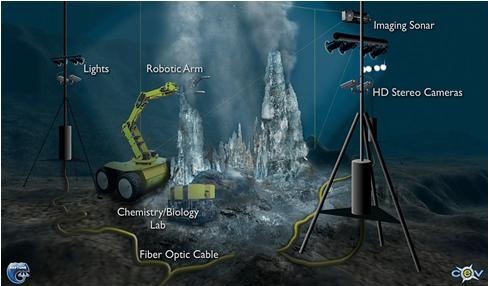You are here
Acoustic Imaging & Quantifying Seafloor Hydrothermal Flow
ACOUSTCS HOME PEOPLE COVIS PROJECTS SOFTWARE & DATA PUBLICATIONS NEWS LINKS
Overview of Acoustic Imaging for the Quantification of Seafloor Hydrothermal Flow

Early concept of how sonar could be used to monitor fluid flow on the seafloor. Image provided courtesy of the NEPTUNE Project and Center for Environmental Visualization, University of Washington.
What is acoutic imaging?
In general, acoustic imaging uses sound to detect and describe objects or featues within objects. Here, we use sonar (sound ranging) to explore the ocean, especially the movement of fluids (water) within the ocean. Sonars emit sound out into the water and listen for reflected and scattered sound to return. Sonars are frequently used to detect the seafloor, find fish, and identify areas of the ocean with unusual density variations or turbulence.
In underwater acoustic imaging of seafloor hydrothermal flow, the sound emitted by the sonar is scattered by particles and rapid turbulent changes in temperature withing the hydrothermal fluids discharged at the seafloor. The sonar's reciever records the amounts and locations of backscattered sound. With a multi-beam sonar, each ping of sound covers a fan-shaped area. Mechanical re-orientation of the sonar moves the fan thorugh space. This way, a volume of fluid can be imaged. Post-processing of the data produces volume images and seafloor maps that show where fluid is being discharge and how it interacts with the ocean as it rises.
Learn more about acoustic imaging here.
What is seafloor hydrothermal flow and why is it important?
At the mid-oceanic ridges and other volcanic systems under the ocean, seawater infiltrates deeply into the crust warming up due to heat from magma and reacting with the crustal rocks. This altered hot seawater rises back to the seafloor forming hot springs at the seafloor. Some of this hot water exits as clear, hot fluids (c. 150° to 400°C) from narrow orifices, precipating metals to from mineralized chimneys and creating rising plumes. Other hot water mixes with cold seawater below the seafloor and as clear, warm (<150°C) fluids exits through cracks in the seafloor and porous sulfide deposits forming distributed deposits and supporting extensive communities of microbes and animals.
These flow regimes are being intensively studied for their role as agents of transfer of heat, chemicals and microbes from the lithosphere into the ocean that globally influence seawater composition, cool the Earth, contribute to climate change, concentrate metallic mineral deposits, and support chemosynthetic ecosystems. Measuring the heat flux transferred by such fluids is critical to both understanding how seafloor hydrothermal venting work and to quantifying the amount of magmatic heat transferred into the ocean over time.
What are our project goals?
Our scientific goal is to increase understanding of seafloor hot springs and to quantify how much heat and chemicals are transferred from the crust into the ocean. Along the way, we seek to improve and develop acoustic and engineering approaches for measureing and quantifying fluid behaviors. We hope to provide near real-time user-friendly data products when our sonar system, COVIS, is deployed. Active reseach includes the development of automated signal processing for the large data acquisition rates and of visual analytics focused on measuring the 3D geometry, flow rates and volume fluxes of buoyant plumes and diffuse discharges.